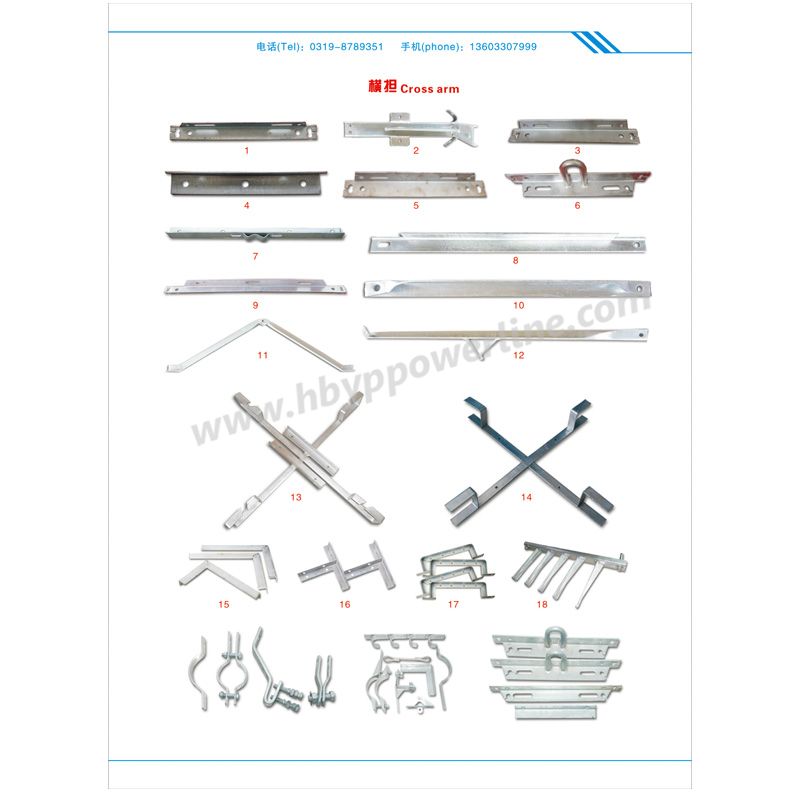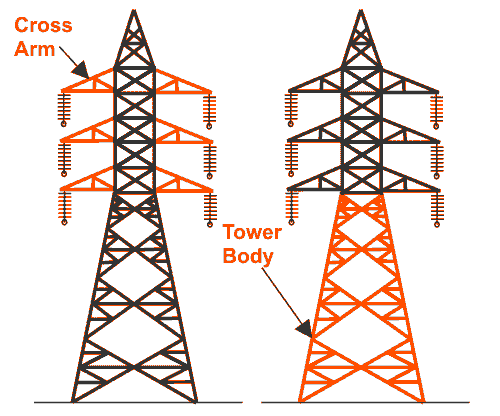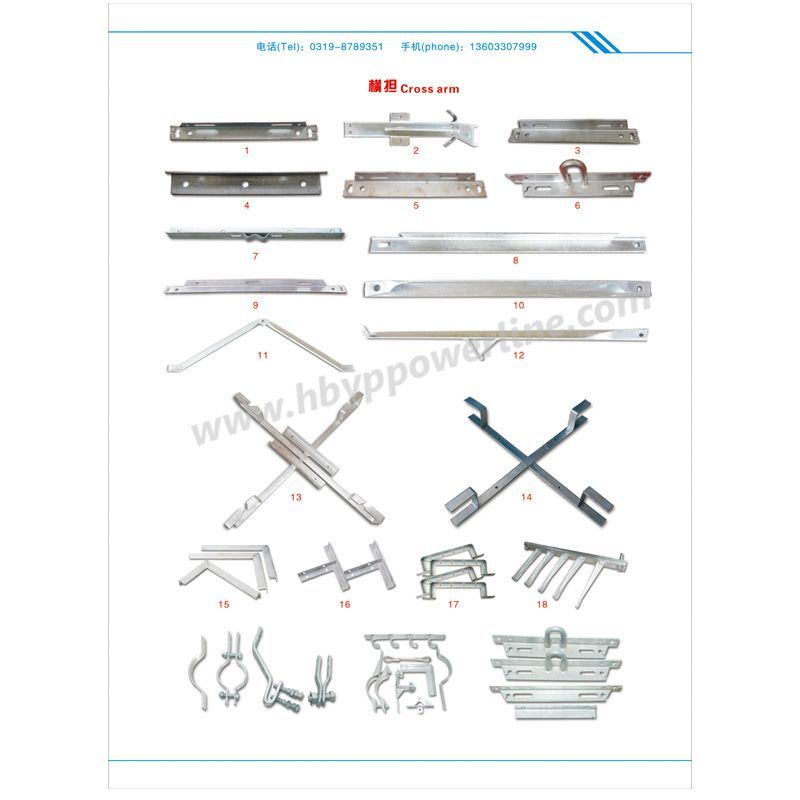An electrical cross arm, also known as a crossarm or power pole cross arms, utility pole cross arms, telephone pole cross arms, light pole cross arms or crossarms for short.
A cross arm is provided, for use in a support structure for conductors within an electrical grid.
Our electrical cross arm is made of hot deep galvanized steel. This material is strong to withstand any physical forces that act against eat. The galvanization protects the steel material from the effects of rust, corrosion, and abrasion.
Steel is the right choice of material for the electrical cross arm due to its tensile strength. It can sustain the mechanical forces which may threaten its stability.
The electrical cross arm comes in five different configurations. There are different configurations for the electrical cross arm. For instance, power pole cross arms are connected with the pin insulator by an insulator pin, and the insulator connects with the wire to realize the power delivery. Light pole cross arms are used on the light pole to support the streetlight power.
Electrical cross arms come in various configurations, but they generally have a similar shape and design. The most commonly used design is the straight bar cross arm. This design features a horizontal bar that is mounted perpendicularly to the utility pole. The straight bar design is favored because of its simplicity and ease of installation. It provides a stable and secure platform for supporting electrical conductors while maintaining the required spacing and clearance.
Another design option is the V-shaped cross arm, although it is not as popular as the straight bar design. The V-shaped cross arm configuration resembles the letter "V," with the ends of the arm pointing upwards. This design offers additional support and strength compared to the straight bar design. By distributing the load more evenly, it helps prevent sagging of the electrical conductors and enhances the overall stability of the powerline. However, due to factors such as cost, availability, and specific application requirements, the V-shaped cross arm design is less commonly used.
Electrical cross arms feature holes of different sizes, depending on the components that will pass through them. The size of the hole is determined by the specific requirements of the power distribution system, such as the diameter of the conductors or the fittings that need to be accommodated.
These pole hardware fittings are available in various sizes or dimensions. The dimensions typically include measurements of the top face, length, and side depth of the cross arm. When purchasing an electrical cross arm, it is important to specify the desired dimensions to ensure a proper fit for the specific application.
The weight and tensile strength of overhead line hardware can vary from one electrical cross arm to another. These factors depend on various considerations, including the material used for construction, the intended load capacity, and the specific requirements of the power distribution network. It is essential to select a cross arm with the appropriate weight and tensile strength to ensure its structural integrity and safe operation within the system.
| Catalogue No. | Dimension(mm) | Weight | Remark | ||
| 1 | H(mm) | b(mm) | L(mm) | ||
| 2 | 5 | 38 | 990 | 2.95 | B-10A |
| 3 | 4.75 | 45 | 3048 | 12 | B-7C |
| 4 | 5 | 50 | 2000 | 10.00 | |
| 5 | 6 | 60 | 2000 | 12.00 | |
| 6 | 6.35 | 76 | 1702 | ||
| 7 | 6.35 | 76 | 1830 | 13.00 | C-20C |
| 8 | 6.35 | 76 | 2440 | 17.5 | C-20D |
| 9 | 6.35 | 76 | 2440 | 23.5 | C-20H |
| 10 | 6.35 | 76 | 3350 | 23.5 | C-20E |
| 11 | 6.35 | 76 | 6100 | 42.7 | C-20G |
| 12 | 8 | 80 | 2000 | 16.50 | |
| 13 | 10 | 100 | 2000 | 21.00 | |
| 14 | 12 | 125 | 2000 | 26.5 | |
Yipeng is Cross Arm Suppliers, Electrical Cross Arm Wholesale choose us!


Cross arm in power transmission
Electrical Cross Arm is an engineered piece of composite equipment used in pole line technology to hold power lines and other electric equipment.
For an electrical cross arm to be reliable, it has to be efficient in both dead-end and tangent applications.
To fulfill the needs of distribution and transmission, you need to choose a strong cross arm engineered for maximum performance.
Electrical cross arms are also known as telephone pole cross arms, light pole cross arms or power pole cross arms.
For example, power pole cross arms are usually connected to an insulator using an insulator pin.
The insulation is then attached to the wires on the power line so that power connection is complete.
Electrical cross arms serve various functions that vary based on the specific application. While they are commonly used by electrical utility companies and telephone companies, they also find applications in refineries, cable companies, and railroads.
The primary purpose of electrical cross arms is to optimize the efficiency and resilience of the electrical infrastructure, especially in different weather conditions. When used in light poles, they assist in supporting street light power lines. In distribution and transmission lines, they provide support for conductors.
Additionally, electrical cross arms act as a connection point between the insulator, cable, and tower. They also ensure that the conductor is positioned at a certain height above the ground, which is a critical requirement. The even spacing between electrical cross arms facilitates the smooth and safe transmission of electricity.
Overall, electrical cross arms play a crucial role in maintaining the integrity and functionality of electrical systems, regardless of the specific application they are used in.
There are different types of electrical cross arms available in the market, with each having a specific function and installation process associated with it. These are categorized in terms of the nature of the job they do.
These are particular types of cross arms used on power poles to connect conductors and insulators. They are required on the power poles to ensure that the electricity is transmitted well. It also has holes in it that will be used to tighten the insulators and the conductors using bolts.
This particular type of cross arms is utilized for short as well as long transmissions. The pole usually separates the cross arm, which distributes the weight in equal proportions. A straight line is usually used for the connection having a firm base of the electrical cross arm.
Also known as the braced horizontal arm, the side arms connect to the pole on single circuits.
These are the cross arms with the most extension as they enable multiple connections at a time on each side. Depending on the connection, the telephone pole cross arms present on a pole vary in number.
These cross arms support different types of light poles such as traffic lights and street lights and have a varied length that depends on the total bulbs that will be supported on it.
Anytime you will be using an electrical cross arm you may need the following accessories too:
It is also known as pigtail hook, pigtail eye bolt, pigtail screw, pigtail hook screws or pigtail fastener.
It used on poles to hang suspension clamps, dead-end clamps and also electrical cross arms among other pole line hardware.
It has a helical end on one side and threads on the other thus the name pigtail bolt.
It is a bolt that is shaped in the form of the letter U and has threads on each end.
They are fasteners used in holding various components to the electrical cross arm.
They are described better depending on the kind of work it will perform.
These are bolts that have threads made all over them.
They do not have heads or tails as both ends are the same, but the sizes vary.
They have nuts used to fasten the other connections on the electrical cross arms from both ends.
Electrical cross arms are utilized for performing various tasks that are based on the application mode and are a crucial part of the infrastructure that is utilized on the telephone companies, railroads, electrical utility services, refineries, and cable companies. These applications need to have electrical cross arms that significantly improves the efficacy and the resilience of the whole system that withstands the different weather conditions.
The purpose of the electrical cross arms in different light poles is to provide assistance for the power lines of street lights. The electrical cross arms are used for providing support to the conductors that are used in the distribution and the transmission lines. It is utilized in holding the insulator as well as the cable close to the main body which is commonly the tower. Moreover, it is highly essential for keeping the conductor above the ground level to ensure the safe and efficient flow of electricity. In addition, these cross arms are used in even spaces for the provision of safety to avoid any short circuit as these are prevented from contacting one another.
The design and construction of electrical cross arms are critical to ensure their structural integrity and performance. Several factors need to be considered during the process:
The type of material used in making electrical cross arms vary depending on the manufacturing company.
Most companies prefer to use timber in making the cross arms as it is durable and can withstand the harsh weather conditions.
Apart from that, other companies use materials such as hot dip galvanized steel and composites can also be used.
Since electrical cross arms hold a lot of loads, the material has to be robust, durable, and resilient to its function.
It is also used outdoors where harsh weather conditions and other accidents may occur.
This is the reason why the material used has to be very strong and durable.
The dimensions of a cross arm, including length, width, and thickness, are determined based on the span between poles, conductor type, and load requirements. Engineering calculations and standards are used to determine the appropriate dimensions to ensure safe and reliable operation.
The most common form of the electrical cross arm is the straight bar design which is visible on many poles.
It is a straightforward design to make and install making it the most preferred type of electrical crossbar.
It does not require extra support for one it has been fastened to the poles and making other installations are easy.
The other shape seen on electrical power lines is the V-shaped cross arm.
It is not a common type because it requires extra support on the poles as compared to vertical cross-arms.
This does not give enough room for the connection of multiple conductors and insulators
The holes on the electrical cross arm are available according to the size of the component it will be attached.
Fittings on the cross arms have to be tight and held in place, so the holes have to be of the right size.
The number of holes drilled on the cross arm should correspond to the number of utilities that will connect to it.
Mainly used to hold the utilities to the cross arm and also to hold the cross arm to the pole.
Different types of locks are used on electrical cross arms depending on the connection.
The types of bolts used include Pigtail bolts, U bolt, and double arming bolts.
The weight of the electrical cross arm depends on the type of material used in making it.
Normally, the materials used vary in weight, therefore, affecting the overall weight of the cross arm.
The proper installation of electrical cross arms is crucial to ensure their effectiveness and longevity. The following steps outline the general process:
The proper installation of electrical cross arms is crucial to ensure their effectiveness and longevity. The following steps outline the general process:
Before installing a cross arm, the utility pole needs to be inspected for structural integrity. Any necessary repairs or reinforcements should be carried out to ensure the pole can adequately support the cross arm and associated hardware.
The cross arm is attached to the utility pole using appropriate hardware, such as bolts or lag screws. Care should be taken to ensure the cross arm is level and securely fastened to the pole, with proper clearances maintained for conductors and other components.
After mounting the cross arm, the power lines or conductors are attached to the insulators and hardware mounted on the cross arm. Proper tensioning and sag calculations are essential to ensure optimal performance and safety of the power distribution system.
The whole process requires being very accurate and in that order, it is necessary to make adjustments such as correct measurements of all components are needed to be taken to make sure that the adjustments are made without any error and the total material utilized in the process is not at all damaged or goes wasted.
1. What is an electrical cross arm?
An electrical cross arm is a fitting utilized in the pole line technology for holding electric equipment such as power lines. It is also called power pole cross arm or utility pole cross arm.
2. What are the types of electrical cross arms?
In most cases, the classification criteria will depend on the nature of the application at hand.
Power pole cross arms
Line-cross arms
Side arms
Telephone pole cross arms
Light pole cross arms
Most of them are made of steel and hang at different levels of the pole.
3. Can electrical cross arms be installed on existing utility poles?
Yes, electrical cross arms can be installed on existing utility poles, provided the poles are structurally sound and capable of supporting the additional load. Proper inspections and engineering assessments should be conducted before installation to ensure the pole's integrity.
+86 319 878 9350
+86 156 1304 7999
+86 319 878 9350
NanYan, DongHuan Road, Shahe, Hebei China
Copyright © Hebei Yipeng Line Equipment Co., Ltd. All Rights Reserved. | Sitemap Powered By 


